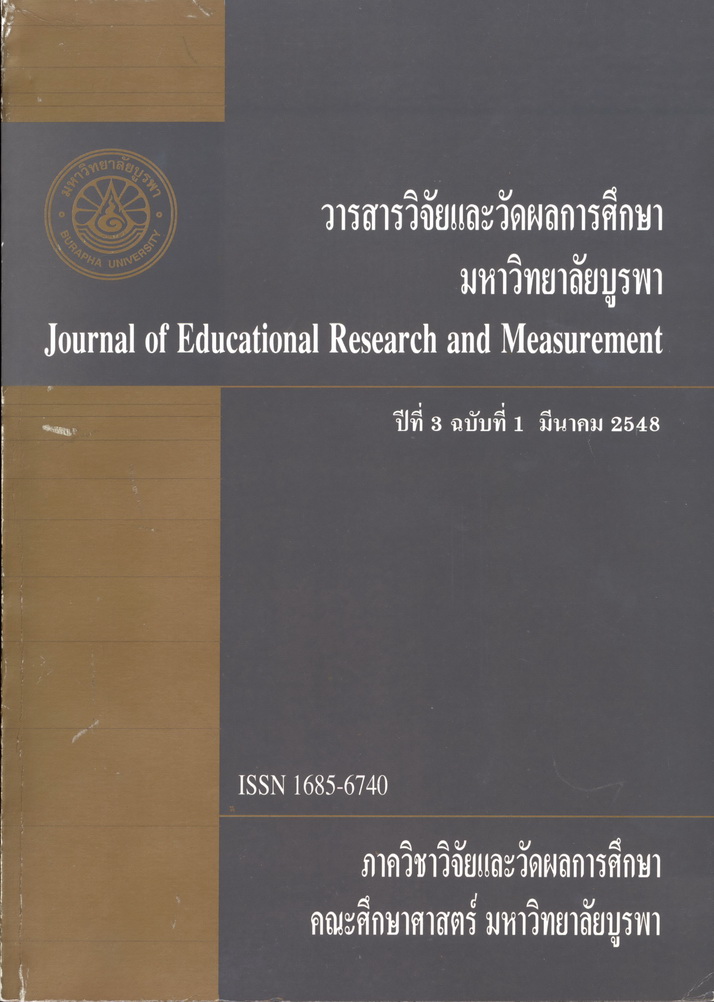การพัฒนาโมเดลความสัมพันธเชิงสาเหตุของความฉลาดทางอารมณ ของนักเรียนชั้นมัธยมศึกษาตอนตน
Main Article Content
Abstract
การวิจัยครั้งนี้มีวัตถุประสงคเพื่อพัฒนาและตรวจสอบความตรงเชิงโครงสรางของโมเดล ความสัมพันธเชิงสาเหตุของความฉลาดทางอารมณของนักเรียนชั้นมัธยมศึกษาตอนตน กลุมตัวอยางเปน นักเรียนชั้นมัธยมศึกษาตอนตน ในโรงเรียนสังกัดสํานักงานคณะกรรมการการศึกษาขั้นพื้นฐาน ภาค ตะวันออก ปการศึกษา 2545 จํานวน 1,000 คน เครื่องมือที่ใชในการวิจัยประกอบดวย แบบสอบถามการ อบรมเลี้ยงดู แบบสอบถามรูปแบบการสื่อสารภายในครอบครัว แบบวัดบุคลิกภาพ แบบสอบถามการ สนับสนุนทางสังคม แบบสอบถามปฏิสัมพันธระหวางครูกับนักเรียน และแบบวัดความฉลาดทางอารมณ การ วิเคราะหขอมูลใชโปรแกรม SPSS ในการหาคาสถิติพื้นฐาน และใชโปรแกรม LISREL 8.50 ในการวิเคราะห ความตรงเชิงโครงสรางของโมเดลความสัมพันธเชิงสาเหตุ ผลการวิจัยแสดงวา โมเดลความสัมพันธเชิงสาเหตุของความฉลาดทางอารมณของนักเรียนชั้น มัธยมศึกษาตอนตน มีความสอดคลองกับขอมูลเชิงประจักษอยูในเกณฑดี โดยพิจารณาจากคาไค-สแควร เทากับ 1.08 คา ที่องศาอิสระเทากับ 11 คา p เทากับ 1.00 ดัชนี GFI เทากับ 1.00 ดัชนี AGFI เทากับ 1.00 ดัชนี CFI เทากับ 1.0 คา SRMR เทากับ .002 และคา RMSEA เทากับ 0.00 ตัวแปรทั้งหมดในโมเดลสามารถอธิบาย ความแปรปรวนของความฉลาดทางอารมณไดรอยละ 94 ตัวแปรที่มีอิทธิพลทางตรงตอความฉลาดทาง อารมณอยางมีนัยสําคัญทางสถิติ คือ บุคลิกภาพของนักเรียน การสนับสนุนทางสังคม การสื่อสารภายใน ครอบครัว และการอบรมเลี้ยงดู สวนตัวแปรที่มีอิทธิพลทางออมตอความฉลาดทางอารมณโดยผานตัวแปร บุคลิกภาพ ไดแก ปฏิสัมพันธระหวางครูกับนักเรียน และเพศ
DEVELOPMENT OF A CAUSAL RELATIONSHIP MODEL OF EMOTIONAL INTELLIGENCE FOR LOWER SECONDARY SCHOOL STUDENTS
Research objectives were to develop and validate a causal relationship model of Emotional Intelligence for lower secondary school students. The sample consisted of 1,000 lower secondary school students under the jurisdiction of the Office of Basic Education Commission in the Eastern Region, Thailand, academic year 2002. Research instruments included the Student Personal Information Questionnaire, the Child Rearing Practices Questionnaire, the Family Communication Questionnaire, the Personality Scale, the Social Support Questionnaire, the Interaction between Teacher and Student Questionnaire, and the Emotional Intelligence Scale. Data were analyzed by descriptive statistical analysis through SPSS, and the causal relationship model was validated with LISREL 8.50. Results indicated that the adjusted model was consistent with empirical data. Model validation measures were found to be: chi-square = 1.08, df = 11, p = 1.00, GFI = 1.00, AGFI = 0.98, CFI = 1.00, SRMR = 0.002, and RMSEA = 0.00. The variables in the model accounted for 94 percent of the variance of Emotional Intelligence. Variables with a statistically significant direct effect on Emotional Intelligence were student personality, social support, family communication, and child rearing practices. Variables having a statistically significant indirect effect on Emotional Intelligence were interaction between teacher and student, and sex.

